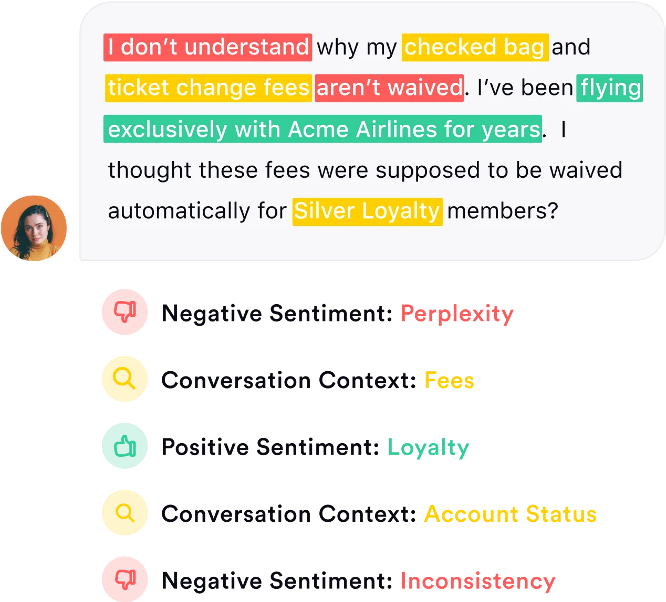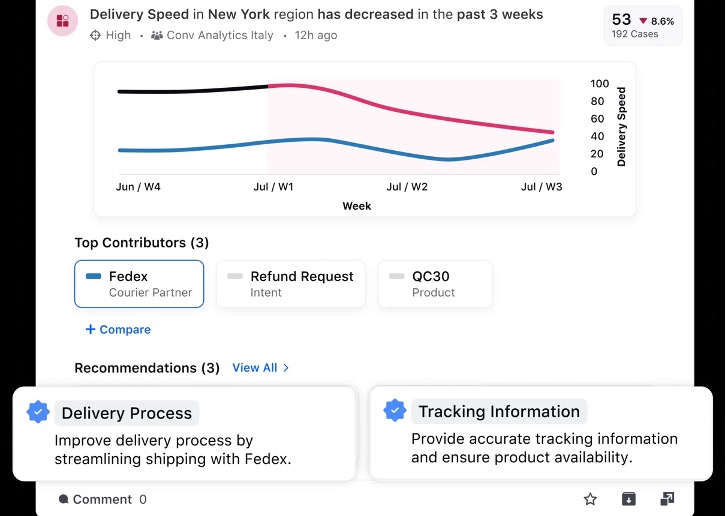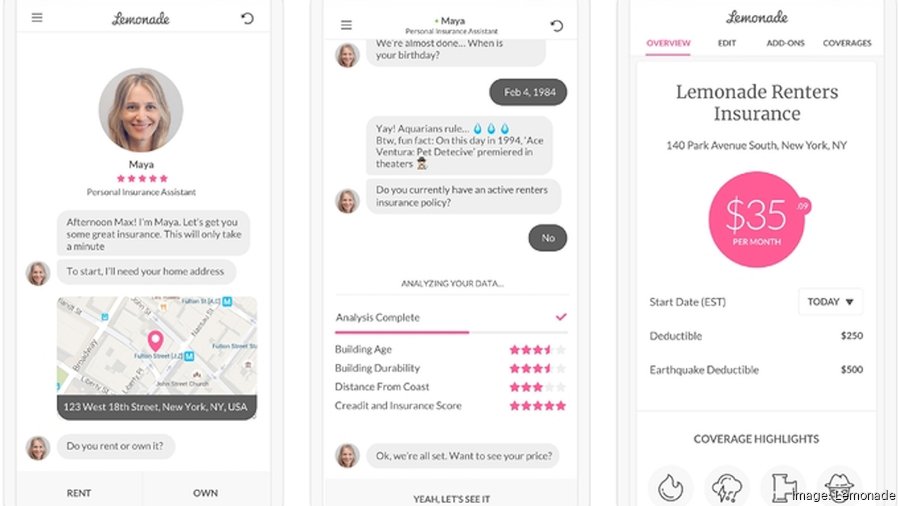What is customer service management?
Customer service management (CSM) is the strategic approach to overseeing and improving all aspects of customer service within an organization. It focuses on long-term strategy building and process optimization, which in turn helps optimize customer service quality and delivery. Improved customer service boosts overall customer experience, loyalty and retention.
Consumer service management encompasses activities such as:
Developing policies and procedures: Creating guidelines for how customer service should be handled.
Training and development: Ensuring customer service agents are well-trained and equipped to handle various situations.
Monitoring and analyzing performance: Using metrics and feedback to continuously improve service quality.
Implementing technology solutions: Utilizing customer service software and tools to streamline operations.
Customer retention strategies: Developing programs to keep customers engaged and loyal.
Efficient customer service management has a positive impact on all key aspects of customer service, including agent productivity and customer service operation. It also uplifts your business's bottom line by enhancing customer retention, brand reputation and revenue.
Key components of customer service for managers to consider
Consumer service management aims to refine your people, processes and tools that translate into premium service experiences and productive workforces. On the people front, there are four broad elements that must be emphasized by customer service managers.
1. Excellent communication skills
Clear, concise and empathetic communication is at the heart of good customer service. Top-notch customer service tools and workflows cannot compensate for faulty customer service training. For example, well-trained customer service agents will be able to handle aggrieved customers more deftly, avoiding issues of escalations and churn.
2. Quick problem-solving abilities
Customer service agents should not only be able to assess and resolve issues, but they must do so quickly. Modern customers appreciate agility, counting it amongst the top 3 qualities that exemplify good customer service. A team that can handle complex situations (such as product malfunctions) either through immediate fixes or through the right redirection will foster trust among customers.
3. Use of advanced technology
Meeting customer demands and industry benchmarks requires customer service leaders and managers to leverage robust customer service tools. Software that comes loaded with advanced features and integrations equips teams to provide quick, personalized solutions at scale. It also empowers agents with productivity tools and customers with self-serve tools, improving agent morale and customer satisfaction (CSAT) alike.
4. Adaptable approach
Customer service teams as well as technology must be adaptable to meet changing customer requirements. Agents need to be flexible to handle unexpected customer service scenarios and expectations. Likewise, technology needs to be scalable to meet new customer service trends and challenges.
For example, call center software that supports call deflection can divert costly voice calls to cost-effective digital channels, especially in periods of peak activity (such as new product launches, product outages, seasonal sales, etc.) This ensures your customer service is managed efficiently without eroding your bank balance or customer trust.
✨Interesting Read: 8 Pillars of Good Customer Service
Customer service management vs customer relationship management
Before we get into the differences, you must understand that customer service management and customer relationship management have certain overlaps, especially in terms of their end goals and outcomes. Both aim to drive customer loyalty and customer-centricity while enabling your sales, marketing and support teams with timely data.
However, CRM is broader in scope, spanning all the functions and activities that play a role in customer relationship building. CSM is one of these activities as it improves interaction quality and relationships. Nonetheless, both CRM and CSM are critical parts of the customer service process. Let’s learn about how they differ.
Aspect | Customer Service Management (CSM) | Customer Relationship Management (CRM) |
Primary focus | Focuses on optimizing customer support and experience across all touchpoints | Enables customer relationship building through data management and interaction analytics |
Core purpose | To provide excellent customer support at every interaction and boost CSAT | To track and manage customer interactions and provide solutions that support sales and marketing activities |
Approach | Proactive. Understand customer pain points before they become tickets | Reactive. Uses customer interaction analytics to identify fails and wins and then implement better resolutions |
Impact on customer journey | End-to-end impact on the customer journey, from first contact to after-sales service | Enhances the customer journey by providing personalized experiences and fostering stronger, long-term relationships |
Use case | A customer’s password request is processed automatically without the need for human intervention | A customer receives a product recommendation through CRM based on their purchase history and past interactions |
✨ Also Read: Customer Relations: Top 5 Strategies to Improve Them
Top 5 benefits of customer service management for businesses
Modern businesses need to go beyond great products and services — and focus on satisfying customers. Effective customer service management can give you the tools and processes needed to satisfy customers. Here are its 5 key business benefits:
1. Boosts customer satisfaction
For roughly 80% of American customers, speed, convenience, well-researched answers and friendly service are what make a branded experience satisfactory, according to latest customer support statistics. Effective customer service management contributes to all of these.
CSM helps businesses proactively resolve issues before they escalate. Its two foundational pillars – customer service automation and customer service analytics empower agents to respond in a way that gratifies customers. The combination of responsiveness, personalization and effectiveness directly boosts customer satisfaction.
2. Fosters customer loyalty and retention
Sound customer service and management work on building consistency in every interaction. One way this happens is by prioritizing omnichannel customer service in which cross-channel interactions with the same customer are unified, ensuring customers don’t have to repeat themselves no matter what channel they choose to get support. Unified context helps your business personalize support, making customers feel heard and appreciated. For 74% of customers, these factors automatically improve trust and loyalty, thus reducing customer churn.
3. Improves brand reputation
Not only do happy customers buy more and stay loyal to a company, but they are also more likely to recommend it to others. CX expert Dan Gingiss points out customers want to share positive experiences more than negative ones but about 66% can't recall when a brand really wowed them. Comprehensive customer service management helps create memorable experiences that customers will want to talk about.
4. Supports business growth
Customer service management can contribute to business growth in several ways. For one, as a business providing exceptional customer experience, price will no longer be the most crucial factor to compete on. More than 40% of customers are willing to spend a premium for convenience and a welcoming experience, according to the research linked above.
In addition, the emphasis on understanding individual customer needs allows you to offer personalized recommendations, opening up upselling and cross-selling opportunities.
5. Yields empowered agents
A successful business must not just service its customers well but should also look after its customer service teams. Consumer service management processes equip teams with all the tools and knowledge that set them up for success.
Agents spend 16% of their time looking for relevant content to support customers. Efficient customer service management fixes this issue by:
Giving 360-degree customer view to agents
Building automated customer service workflows
Surfacing relevant knowledge recommendations automatically
Such processes and tools allow agents to resolve customer issues quickly and confidently, which improves their morale and job satisfaction.
✨ Editor’s Pick: A Day in the Life of a Gen Z Support Agent
Best practices to implement customer service management strategies
For best implementation, consumer service management requires a well-thought-out strategy spanning the following steps.
Define your customer service goals
The overarching customer service goals of your company will set the tone for your customer service management strategies. This is where you should start. Avoid vague goals like “improve customer service” that are not actionable. Instead, formulate measurable and realistic goals tied to your customers’ primary pain points.
For instance, if slow response is one of your customers’ top peeves, your service goal could be to improve response time by 30% in 6 months. This makes your goal specific, measurable, attainable, relevant and time-bound (SMART). In turn, it leads to clear metrics and strategies. You may consider a conversational AI platform for delivering quick, automated responses and improving customer sentiment.
Practical tips:
Get insights into your customer service goals from key stakeholders across all customer-facing teams like sales, marketing and support to ensure alignment.
Identify key performance indicators (KPIs) or customer service metrics at the onset to track progress. Some of the most common ones include customer satisfaction scores (CSAT), Net Promoter Score (NPS) and customer effort score (CES).
Improve CSAT by 200% Within a Year
Sprinklr’s customer service software uses advanced AI to read between the lines of customer conversations and identify the customer’s intent and sentiment. It can even predict CSAT in real time so your agents can moderate their strategies accordingly.

Curious to learn more? Take a tour of Sprinklr Service today!
Map the customer journey
Once you get a firm grip on your customer service goals and how you plan to achieve them, the next step in the customer service management process must be to map the customer journey. Walk in the customer’s shoes and sense their pain points, which become opportunities to improve your customer experience. To do this, create detailed customer personas and follow them across different customer touchpoints. Analyze the customer interactions and identify the friction points. Compile all this information in a detailed customer journey map - the compass that guides your entire customer service management.
Practical tips:
Visualize the entire customer lifecycle from discovery to purchase and retention.
Leverage real feedback to understand customer sentiment and use AI to identify patterns in it.
Use technology to support service goals
It’s vital for customer service managers to leverage prevalent technology to its full potential and minimize human errors. For instance, using automation tools for routine tasks like ticket routing, feedback gathering and customer service reporting can save hours and hours of production time.
Apart from saving labor, there are myriad benefits to be enjoyed by leveraging cutting-edge technologies like Generative AI in customer service, such as:
Moderating customer service responses to sound more human
Providing contextual resources to customers and agents
Automating quality management with real-time performance analysis
For example, Sprinklr’s generative AI enrichment (Sprinklr AI+) produces detailed analytics on customer service performance along with recommendations to optimize the process.

Build and train a great customer service team
Failproof customer service management doesn’t happen by chance. It calls for rigorous agent training and coaching as well as agent empowerment. A competent team can dramatically improve the quality and consistency of customer service interactions.
Besides imparting product knowledge, train your agents in your customer service philosophy and tone so they uphold your brand values in interactions. Put their knowledge to test via role-playing scenarios and reward them for demonstrating skills like customer empathy, active listening and problem-solving. Use AI-powered quality management software to calibrate their performance using AI scoring and scorecards.

Dig deeper into customer feedback
Customers are constantly providing feedback whether you’re listening or not. Listening to your customers is a non-negotiable part of customer service management strategy. Collect feedback through customer surveys, social listening and analytics to identify what’s working and what’s not. 89% of customers want companies to collect their input and make changes. Once you identify potential areas for improvement, talk with your team to glean valuable insights into actionable outcomes.
For instance, a company may notice an unusually high churn rate after the introduction of a new feature. After speaking with customers who canceled their subscriptions, they discovered that the new feature interferes with an existing one that was important. Using this information, they can redesign its functionality to work better.
Practical tips:
Validate survey responses with comprehensive feedback from other channels, such as your website, review platforms and social media. This way, you are sure of the feedback’s veracity and can address it with confidence.

Successful implementation of consumer service management: 3 examples
Effective customer service management can have a positive impact on any business — from finance to entertainment. Here are three real-world examples of CSM strategies that have worked.
Lemonade Insurance: Empathetic experience for customers and agents
Lemonade Insurance is an excellent case study of how chatbots not only improve customer experience but also reduce the load on service agents. The company introduced Maya, an AI-powered chatbot that leads with customer empathy to enhance customer support and streamline the insurance process.
Maya was designed to be friendly and approachable. It takes on time-consuming tasks like filling out insurance forms, guiding users through the quote process and upselling and cross-selling smartly.
As a result, Maya handles up to 25% of Lemonade’s customer inquiries, reducing the load on its agents and freeing up their time for more urgent issues. The chatbot has also been a key driver in selling 1.2 million insurance policies since its launch. Lemonade’s use of Maya highlights the power of AI in customer service management to offer personalized, efficient and scalable support without overburdening employees.

Spotify: Transforming music-sharing experiences
Spotify has established itself as the top music streaming and sharing platform in the world. How? It used a combination of customer journey mapping, adapting to technological advancements and improving its features based on customer feedback.
Spotify used a marketing agency to identify the most effective moments in a user's journey where music-sharing could naturally enhance their experience in depth. Additionally, it prioritized user-preferred features, optimized music recommendations and improved the user interface based on feedback and multiple iterations. Simultaneously, it provided transparency and better rights to all artists on its platform.
Today, the app has over 626 million users and 246 million subscribers in more than 180 markets. Its satisfied customers trust that they are listened to, are loyal and vocal about the company’s positives.
Fooji: Fostering connections with exceptional service
Fooji, a Kentucky-based company that cultivates engaging fan experiences for brands like HBO and Panera, was looking for a robust solution to manage social promotions and sweepstakes for its clients as it scaled. The company specifically wanted to leverage automation to understand the hidden nuances in direct message conversations, distinguish social from email tickets and track its progress across platforms.

Fooji turned to Sprinklr Service to leverage self-serve for quick and streamlined ticket actions, AI prioritizations for ticket creations and updations and integration of it all with its own app. By doing this, Fooji was able to handle a large volume of customer tickets with remarkable efficiency — 99.92% of tickets were closed within SLAs and the average ticket close time was reduced by 99%. Read the full story here.
If you want to replicate the success of Fooji and other brands mentioned above, consider turning to a well-integrated, customized customer service solution for excellent customer service management strategies that will keep your customers hooked to your brand. Sprinklr Service can be the solution for you. Grab a personalized demo today!
FAQ
related products
Thank you for contacting us.
A Sprinklr representative will be in touch with you shortly.
Contact us today, and we'll create a customized proposal that addresses your unique business needs.
Request a Demo
Welcome Back,
No need to fill out any forms — you're all set.


